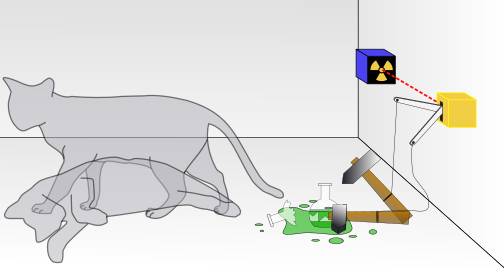
Schrödinger's cat: a cat, a
flask of poison, and a radioactive source are placed in a sealed box. If
an internal monitor detects radioactivity (i.e. a single atom decaying), the
flask is shattered, releasing the poison that kills the cat. The Copenhagen
interpretation of quantum mechanics implies that after a while, the cat is simultaneously alive and
dead. Yet, when one looks in the box, one sees the cat either alive
or dead, not both alive and dead. This poses the question of when
exactly quantum superposition ends and reality collapses into one possibility or
the other.
Schrödinger, E. Quantum Theory and Measurement
English translation: John D. Trimmer, Proceedings of the American
Philosophical Society, 124, 323-38 (1980), Reprinted in, 1983. p 152
In 1935 Schrödinger published an essay describing the
conceptual problems in quantum mechanics (QM1). A brief paragraph in this essay
described the cat paradox. A cat is penned up in a steel chamber, along with Al
device (which must be secured against direct interference by the cat). The
device is a Geiger counter in which there is a tiny bit of radioactive
substance, so small that perhaps in the course of one hour one of the
atoms decays, but also, with equal probability, perhaps none; if it happens,
the counter tube discharges and through a relay releases a hammer which
shatters a small flask of hydrocyanic acid. If one has left this entire system
to itself for an hour, one would say that the cat still lives if
meanwhile no atom has decayed. The first atomic decay would have poisoned it.
It is typical of these cases that an indeterminacy
originally restricted to the atomic domain becomes transformed into macroscopic
indeterminacy, which can then be resolved by direct observation. We know
that superposition of possible outcomes must exist simultaneously at a
microscopic level because we can observe interference effects from these. We
know that the cat in the box is dead, alive or dying and not in a smeared out
state between the alternatives. When and how does the model of many microscopic
possibilities resolve itself into a particular macroscopic state? When and how
does the fog bank of microscopic possibilities transform itself to a definite
macroscopic state. That is the measurement problem and Schrödinger’s cat is a
explanation of that problem.
No comments:
Post a Comment